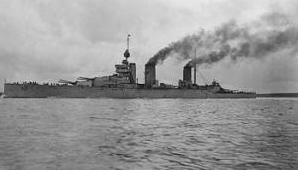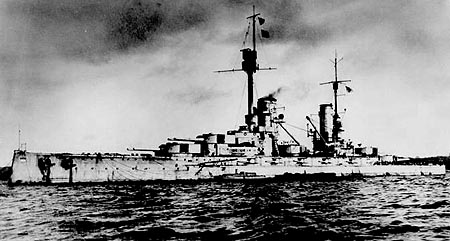|
|
|
|
|
|
|
BATTAGLIA NAVALE DELLO JUTLAND
NAVAL BATTLE OF JUTLAND
|
|
|
|
|
|
|
31 MAGGIO 1916 - 1° GIUGNO 1916


STORIA / HISTORY
L'INIZIO DELLA BATTAGLIA /
Verso le due di pomeriggio del 31 maggio 1916 il grosso della flotta d'alto mare tedesca avanzò da est, preceduta, di circa 50 miglia, dalla squadra dell'ammiraglio Hipper, approssimativamente sullo stesso parallelo della squadra di incrociatori da battaglia dell'ammiraglio Beatty, che salpando da Firth of Forth era giunto a destinazione prima delle altre squadre inglesi.
Le formazioni avversarie avanzarono l'una contro l'altra a gran velocità nel tentativo di portarsi nella posizione di tiro più favorevole: Beatty, contando sull'arrivo del resto della flotta, intendeva circondare a poppa le navi tedesche, ma Hipper, comprendendo l'intenzione del nemico, invertì la rotta in direzione sud-est/est muovendo parallelamente agli inglesi verso il grosso delle forze di Scheer.
Alle 14.30 del 31 maggio il grosso della flotta tedesca si trovava a circa 55 miglia al largo della costa dello Jutland, all'altezza del 56° parallelo ed era preceduta da di 57 miglia verso nord dal gruppo esplorante dell'ammiraglio Hipper, del quale facevano parte i 5 incrociatori da battaglia.
Il grosso della Grand Fleet alla stessa ora, era a circa 80 miglia a nord ovest della squadra di Hipper ed era a sua volta preceduto, 64 miglia a sud-est dalla sua avanguardia, comandata dall'ammiraglio beatty, forte, tra l'altro, di 4 navi da battaglia del tipo Queen Elizabeth (Barham, Valiant, Malaya, Warspite) e di 6 incrociatori da battaglia (Queen Mary, Lion, Tiger, Princess Royal, Indefatigable e New Zeland). Le due avanguardie si trovavano all'incirca sullo stesso parallelo, il 57° e distavano fra loro 40 miglia.
Alle 14.20 l'incrociatore leggero britannico Galatea avvistò e segnalò due torpediniere nemiche, attratte nella zona dal fumo di un mercantile danese.
Tutti gli altri incrociatori leggeri britannici, che formavano un sottile schermo di protezione attorno alla forza dell'ammiraglio Beatty diressero verso il Galatea che, 8 minuti dopo la segnalazione, apriva il fuoco contro le navi nemiche che apparivano una dopo l'altra all'orizzonte.
Prima di salpare l'ammiraglio Jellicoe aveva impartito a Beatty l'ordine di precederlo in direzione di Heligoland di 65 miglia; di mantenere questa rotta fino alle 14 e a meno di non aver incontrato unità nemiche, di tornare indietro fino a distanza visiva dal gruppo principale delle corazzate.
Questo si sarebbe poi spostato verso est e Beatty avrebbe effettuato un'altra puntata verso sud. Era, insomma, un rastrellamento in grande stile del Mare del Nord. Si era perso un po’ di tempo perché distratti dal fumo di mercantili e pescherecci; alle 14.15 l'ammiraglio Beatty aveva già impartito l'ordine di invertire la rotta e per prime l'avevano eseguito le navi da battaglia.
Quando giunse il messaggio del Galatea tutto il gruppo di Beatty, ad esclusione del naviglio di scorta, stava già navigando verso nord.
At the 14.30 of May 31 the big one of the German fleet was found to around 55 miles offshore the coast of the Jutland, to the height of the 56° parallel and you/he/she was preceded from of 57 miles toward north from the group esplorante of the admiral Hipper, of which you/they made part the 5 battle cruisers.
The big one of the Grand Fleet to the same time, was to around 80 north west miles of the team of Hipper and it was preceded in turn, 64 southeast miles from his/her avant-garde, commanded by the admiral beatty, strong, besides, of 4 battle ships of the type Queen Elizabeth (Barham, Valiant, Malaya, Warspite) and of 6 battle cruisers (Queen Mary, Lion, Tiger, Princess Royal, Indefatigable and New Zeland). The two avant-garde were found approximately on the same parallel, 57° and distavano among them 40 miles.
At 14.20 o'clock the British light cruiser Galatea sighted and signalled two hostile torpedinieres, attracted in the zone by the smoke of a Danish merchantman. All the other British light cruisers, that formed a thin screen of protection around admiral Beatty's strength directed toward the Galatea that, 8 minutes after the signaling, it opened the fire against the hostile ships that appeared one after the other to the horizon.
Before setting sail the admiral Jellicoe it had imparted to Beatty the order to precede him/it in direction of Heligoland of 65 miles; to maintain this rout up to the 14 and to less than not to have met hostile unity to return back up to visual distance from the mastergroup of the battleships.
This would be moved then toward east and Beatty it would have effected another episode toward south. It was, in short, a raking in great style of the Sea of the North. A po of time was lost because distracted by the smoke of merchantmen and fishing-boats; at 14.15 o'clock the admiral Beatty had already imparted the order to reverse the rout and for first the battle ships had performed him. When the message of the Galatea the whole group of Beatty came, to exclusion of the shipping of escort, you/he/she was already sailing toward north.
LE PIU' GRANDI BATTAGLIE NAVALI (NAVAL BATTLES)
BATTAGLIA NAVALE DELLO JUTLAND / JUTLAND NAVAL BATTLE
PORTAEREI NELLA STORIA (AIRCRAFT CARRIERS)
NAVI DA GUERRA (WARSHIPS AND BATTLESHIPS)